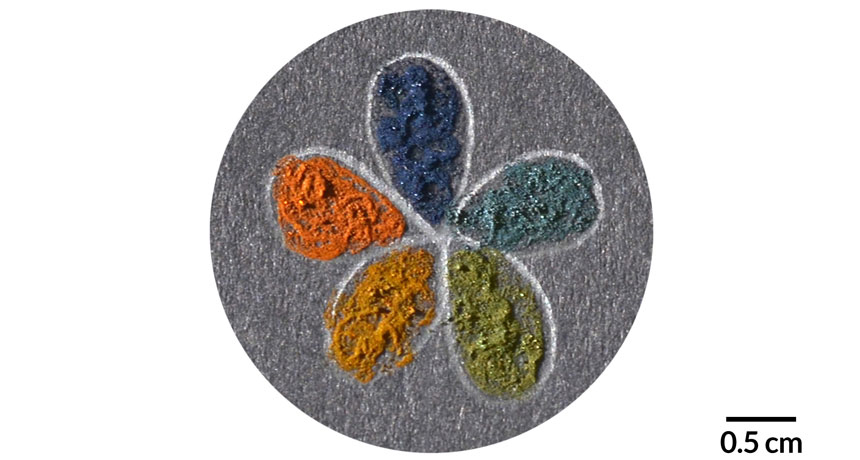In the vibrant world in which we live, colors are significant for not only aesthetics and pleasure, but also for communication, signaling and security. Colors are produced through either absorption of light by molecules —pigmentary colors — or scattering of light by nanostructures — structural colors.
Structural colors enable the creation of a spectrum of non-fading colors without pigments, potentially replacing toxic metal oxides and organic pigments. However, there are challenges. Many traditional structural colors are iridescent and thus not useful for wide-angle displays. Recent examples of non-iridescent structural colors have been found to lack sufficient color saturation in the absence of absorbing materials to reduce incoherent scattering.

The pigments in these supraballs can be used in everything from clothing and paint to cosmetics.
Core-shell nanoparticles with a shell refractive index (RI) similar to water have been used to tune the spacing between cores to achieve optimal scattering for non-iridescent colors, but only in solution. Even though both bottom-up and top-down methods have been widely used, there is a demand for a scalable process for mass production of structural colors.
Collaborative effort
In this research, scientists from The University of Akron, Northwestern University, and University of Ghent demonstrate a feasible solution for producing structural colors inspired by bird feathers. Their findings have been published on Science Advances, an open access online journal established by Science.

Dr. Ali Dhinojwala
Nature provides many spectacular examples of structural colors, such as duck wing feathers and wild turkey feathers. In continuation of their earlier research that unraveled the fundamental properties of melanin — a family of natural pigments found in skin, hair, eyes and the plumage of brightly colored birds — these examples served as bio-inspiration for the design of core-shell synthetic melanin nanoparticles for the production of bright structural colors.
Melanin has been around for millions of years. “Melanin is an important biomaterial that has so far been underutilized in materials science and technological applications,” says UA’s Dr. Ali Dhinojwala, H.A. Morton Professor of Polymer Science and one of the principal investigators on the project.
In this most recent research, the team has found that tiny packets of synthetic melanin produce structural color when they are packed into semi-ordered spherical particles. Structural color occurs through the interaction of light with materials that have patterns on a sub-micron scale, which reflect light to make some wavelengths brighter and others darker.
Full spectrum of colors possible
“The chemistry we use to make these particles is based on the main ingredient that goes into making melanin,” notes Dhinojwala. “Then we take these melanin particles and self-assemble into a structure using a very straight forward process. It is similar to things we see in our homes, like mixing oil and water together creating emulsions. Those emulsions essentially allow us to assemble these particles into photonic inks which we call photonic supraballs.”
These nanoparticles were self-assembled using a one-pot reverse emulsion process, adds Ming Xiao, currently a postdoctoral research fellow. “It resulted in bright and non-iridescent supraballs. With the combination of only two ingredients, synthetic melanin and silica, we can generate a full spectrum of colors. The use of melanin as the core material can increase the brightness and saturation of supraballs due to its unique combination of high RI and broadband absorption of lights. In addition, melanin is biocompatible and can dissipate almost 90% of the UV radiation into heat within a nanosecond, making those melanin-based supraballs suitable for cosmetics or UV-resistant inks.”
Other leading members of the research team are Dr. Nathan C. Gianneschi of Northwestern University and Dr. Matthew Shawkey, formerly with UA and now an associate professor of biology at the University of Ghent in Belgium. Rounding out the team are scientists from UC San Diego, Sichuan University and Shanghai Jiao Tong University.
See also:
► ScienceNews: Tiny ‘supraballs’ put a new spin on creating long-lasting color
► Science: New dyes that don’t fade are made of the same molecule that colors your skin
Media contact: Lisa Craig, 330-972-7429 or lmc91@uakron.edu.
